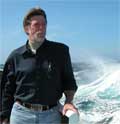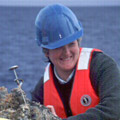Overview
A QUIET REVOLUTION
2005-09-25
 |
 |
The Ocean Sciences are in the midst of a transformation. Oceanography is the study of all processes operating within the ocean basins - from shoreline to shoreline, from atmosphere-ocean interactions near the surface, to ocean-earth exchange at the seafloor. We have traditionally studied the ocean with ships, satellites, and occasional instrument-laden moorings. However, ships can only be in one place at one time and satellites mostly provide information about the uppermost portions of the ocean. Yet many of the most powerful and fascinating processes operating in the oceans occur unpredictably and/or evolve rapidly in both time and space throughout the volume of the oceans. We have not studied these processes or events well because the tools we have been using are not well suited to the task.
For example, basic ocean processes such as massive storms, erupting submarine volcanoes, giant earthquakes, phytoplankton blooms, rapid growth of exotic microbial life thriving in the seafloor, and the formation of metal or energy deposits, often take place in a pulsed or episodic fashion. We cannot understand or predict these processes without being present throughout the ocean, all the time. We need the capacity to detect, follow, measure and sample these rapidly evolving, energetic events as they unfold. Developing and utilizing such capabilities is the heart of the ocean transformation.
Societal and Intellectual Benefits
There are powerful societal and intellectual reasons to develop new strategies for studying the ocean basins. Rapid changes in the ocean can powerfully influence people living on the continents. Especially near shorelines, but even in mid-continent like Kansas or Nigeria, global oceanic circulation patterns directly influence weather, local climate conditions, and crop production.
Life on earth may have originated within the sub-oceanic crust, and a vast reservoir of exotic microbes certainly thrives there. Within submarine volcanic systems, brilliantly-colored life forms cluster around vigorously venting fissures well below the depth at which sunlight penetrates seawater. There are far more life forms throughout the ocean than we realized even 5 years ago, and many of them are being discovered now using new approaches pioneered during the Human Genome Project. Study of these organisms is providing new insights into how life first evolved on Earth and guides to where life might exist on other planets. In addition, investigations of organisms living in extreme environments provide hints that the ocean may be a rich pool for future pharmaceuticals and catalytic material for industrial use.
Rapid Changes in Technology
Technologically, we are shifting towards a powerful new operational paradigm for ocean research that may soon involve many thousands of robotic sensor arrays that can communicate at the speed of light with scientists, educators, and the public on the continents. These distributed sensor networks will provide instantaneous information about major events (both predictable and unpredictable) taking place within an otherwise remote and often hidden world beneath the waves. New technologies are evolving rapidly and interactively to permit us to observe the ocean depths with a visual/acoustic acuity that is beginning to rival that of humans on land. We will soon determine genomic characteristics of myriad tiny life forms throughout the ocean volume with the speed and accuracy of laboratories developed initially for land-based genetic research.
VISIONS05 - A Sea of Change
The VISIONS05 Cruise is emblematic of the change that is taking place within Ocean Sciences in that the researchers and educators involved are beginning to develop and apply novel approaches to study the interactive, energetic processes that operate within the ocean basins and to directly bring this approach and discovery process to educators and the public. There are five key components to the VISIONS Cruise:
- Plate Tectonically-driven Microbial Fluxes from the Seafloor to the Deep Ocean;
- Probing the Limits to Life in an Extreme Environment
- REVEL: Research and Education: Volcanoes, Exploration and Life
- High Resolution Seafloor Mapping: Scientific Cable Route Survey for NEPTUNECanadali>
- Live Broadcast of High Definition Tele-Video From an Active Deep Sea Volcano
Each of these cruise elements are complementary to each other and each has funding from its own sponsor(s). The paragraphs below capture the essence of the five programs and this web-site develops further elements of these programs.
Plate Tectonically-driven Microbial Fluxes: Seafloor to the Deep Ocean
Virtually all aspects of plate tectonic interactions result in forced or thermally induced fluid migration through the oceanic crust, the overlying sediments and into the deep ocean. Those crustal fluids carry dissolved chemicals from submarine rocks and volcanic gases that provide nutrients for microbial growth. The Keck Foundation is supporting a major investigation into the linkages among earthquake activity, fluid flow between the crust and the overlying ocean, fluid-driven chemical transport, and microbial blooms that result from these episodic events.
This program has resulted in the first installation of a seismic array utilizing buried broadband seismometers. The first year of this experiment documented over 12,000 earthquakes! The ultimate experiments to study such systems require an infrastructure like the planned cabled regional observatory called NEPTUNE (http://www.neptune.washington.edu/). The cruise is exploring the early stages of defining a proto-NEPTUNE approach to documenting, sampling, and modeling many of the processes that are so difficult to examine with either a ship or a satellite. We have been running experiments on the Endeavour Ridge for the last 4 years to identify the approaches and instrumentation scenarios that will work when NEPTUNE capabilities are available. On the VISIONS05 cruise, we are recovering and redeploying an array of in situ instruments to monitor the physical, chemical, and biological characteristics of vent fluids and a network of sophisticated seismometers that allow detection of both small and large earthquakes, and the movement of magma beneath the Endeavour Ridge.
Probing the Limits to Life in an Extreme Environment
Within the walls of active submarine smokers, where steep gradients in thermal and chemical conditions exist, the limits to life are beginning to be defined. This environment offers significant technical challenges. However, with support from the National Science Foundation Ridge 2000 program (http://www.ridge2000.org/), we have developed a novel microbial incubator that houses an array of environmental sensors and fluid samplers designed to withstand the harsh conditions present within the walls of the chimneys. Distributed along these sensors is a diverse array of materials that provide surfaces for colonization by microbes that live within the warm, porous and fluid-saturated chimney walls. This set up provides a way to directly measure the environmental conditions that the microbes experience and recover them for lab based genetic and culturing studies. During this cruise we will deploy and recover the incubators from the walls of up to 5 active chimneys and examine the new microbial colonies that have grown within the instruments over the one-month period. They will then be deployed for the next year.
These systems are natural laboratories for studying microbial metabolic processes thought to be ancient on Earth and results from this study provide hints that life can live at much higher temperatures than previously believed. If this is true there may be an extensive hot biosphere beneath the seafloor that may be significantly impacted by seismic and volcanic perturbations. The Keck experiment strives to shed light on these questions.
The REVEL Project: Research and Education: Volcanoes, Exploration and Life
REVEL is an NSF-funded personal and professional development program offering opportunities for K-12 teachers to "do" science in the largely unexplored world of deep ocean processes. Eager to bring inquiry to their classrooms, teachers embark on journeys of discovery deep below the Pacific Ocean - a novel program in the extreme environment of hydrothermal systems for a unique research and personal experience. Teachers collaborate with scientists on a suite of wide ranging projects from seismology to genomics. For nine years, workshops, lectures, research projects and sea-going adventures held between the shadow of the Cascade Mountains and the depths of underwater volcanoes off the Canada-Washington-Oregon coast have immersed educators in rigorous, practical and theoretical approaches to the craft of the scientific process. REVEL brings together a passionate community of scientists, educators, and seagoing professionals, all engaged in pushing the boundaries of learning. Participants describe the REVEL Project as "life altering". Enthralled and empowered by the research process teachers engage hundreds of students for years to come in the challenges of understanding the natural world and its impact on daily life.
High Resolution Seafloor Mapping--Scientific Cable Route Survey-NEPTUNE-Canada
Mapping of the seabed is critical in engineering a safe and secure cable route for the fiber optic network that makes up NEPTUNE. With a diameter of only a few centimeters, cables are susceptible to external hazards like fishing, anchors, and suspensions over sharp ridges. To optimize the longevity and the security of the cables, we must collect the best possible information about the seafloor shape. The Autonomous Benthic Explorer (ABE) is a fully automatic underwater robotic vehicle carrying multiple sensors designed to map the seafloor and the near-bottom water environment. On this cruise, we are using a multi-beam sonar to assemble detailed maps of the seafloor shape or bathymetry. The resulting maps will serve multiple purposes. They will guide the installation of the Neptune Canada seafloor science node and all supporting cables. Additionally, scientists will use the detailed bathymetry to choose sites for a wide spectrum of seafloor experiments. Finally, these maps will contribute to an overall understanding of the tectonic and hydrothermal evolution of the Endeavour Segment. The program is funded both by NEPTUNE-Canada and NSF Ocean Sciences.
LOOKING: Live Broadcast of HDTV From an Active Deep Sea Volcano
The LOOKING Project is funded by NSF (http://www.nsf.org) to examine mechanisms by which oceanographers can optimize their efficiency and effectiveness at operating a NEPTUNE-like seafloor observatory that will allow routine interactions with many vigorous processes throughout the ocean volume via fiber optically connected instrumental arrays. As one element in that effort we have chosen an early test case of utilizing Band Width limited HDTV data streams from the deep-sea floor to illuminate the environment associated with submarine hydrothermal systems at a depth of nearly 2.3 km. Our goal will be to stream HDTV during day-time hours Mon - Friday September 26-30 when the Robotic Vehicle JASON II is working at the seafloor. We will also present a live HDTV Broadcast on September 28, and 29 between 2 and 3 pm (Pacific Time)(http://www.researchchannel.org/visions05/index.asp). Stunning images of the seafloor vent habitats and live coverage of active experiments in those harsh environments will be presented with dialogue among scientists involved.
John R. Delaney and Deborah S. Kelley Co-Chief Scientists - VISIONS05 Cruise